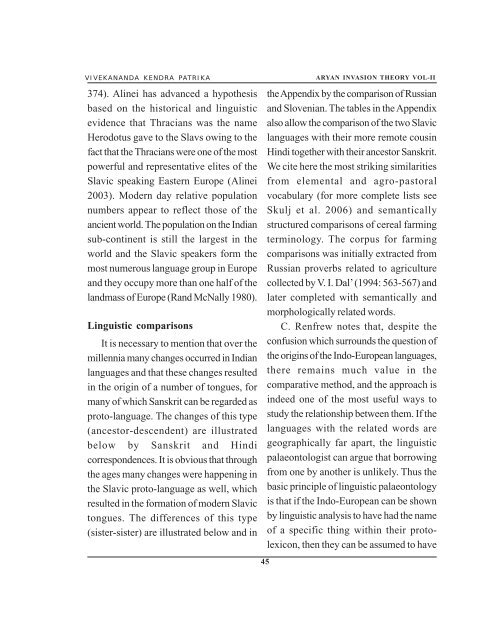Aryan Invasion Theory - Publication - Vivekananda Kendra
Aryan Invasion Theory - Publication - Vivekananda Kendra
Aryan Invasion Theory - Publication - Vivekananda Kendra
You also want an ePaper? Increase the reach of your titles
YUMPU automatically turns print PDFs into web optimized ePapers that Google loves.
VIVEKANANDA KENDRA PATRIKA ARYAN INVASION THEORY VOL-II<br />
374). Alinei has advanced a hypothesis<br />
based on the historical and linguistic<br />
evidence that Thracians was the name<br />
Herodotus gave to the Slavs owing to the<br />
fact that the Thracians were one of the most<br />
powerful and representative elites of the<br />
Slavic speaking Eastern Europe (Alinei<br />
2003). Modern day relative population<br />
numbers appear to reflect those of the<br />
ancient world. The population on the Indian<br />
sub-continent is still the largest in the<br />
world and the Slavic speakers form the<br />
most numerous language group in Europe<br />
and they occupy more than one half of the<br />
landmass of Europe (Rand McNally 1980).<br />
Linguistic comparisons<br />
It is necessary to mention that over the<br />
millennia many changes occurred in Indian<br />
languages and that these changes resulted<br />
in the origin of a number of tongues, for<br />
many of which Sanskrit can be regarded as<br />
proto-language. The changes of this type<br />
(ancestor-descendent) are illustrated<br />
below by Sanskrit and Hindi<br />
correspondences. It is obvious that through<br />
the ages many changes were happening in<br />
the Slavic proto-language as well, which<br />
resulted in the formation of modern Slavic<br />
tongues. The differences of this type<br />
(sister-sister) are illustrated below and in<br />
45<br />
the Appendix by the comparison of Russian<br />
and Slovenian. The tables in the Appendix<br />
also allow the comparison of the two Slavic<br />
languages with their more remote cousin<br />
Hindi together with their ancestor Sanskrit.<br />
We cite here the most striking similarities<br />
from elemental and agro-pastoral<br />
vocabulary (for more complete lists see<br />
Skulj et al. 2006) and semantically<br />
structured comparisons of cereal farming<br />
terminology. The corpus for farming<br />
comparisons was initially extracted from<br />
Russian proverbs related to agriculture<br />
collected by V. I. Dal’ (1994: 563-567) and<br />
later completed with semantically and<br />
morphologically related words.<br />
C. Renfrew notes that, despite the<br />
confusion which surrounds the question of<br />
the origins of the Indo-European languages,<br />
there remains much value in the<br />
comparative method, and the approach is<br />
indeed one of the most useful ways to<br />
study the relationship between them. If the<br />
languages with the related words are<br />
geographically far apart, the linguistic<br />
palaeontologist can argue that borrowing<br />
from one by another is unlikely. Thus the<br />
basic principle of linguistic palaeontology<br />
is that if the Indo-European can be shown<br />
by linguistic analysis to have had the name<br />
of a specific thing within their protolexicon,<br />
then they can be assumed to have

















